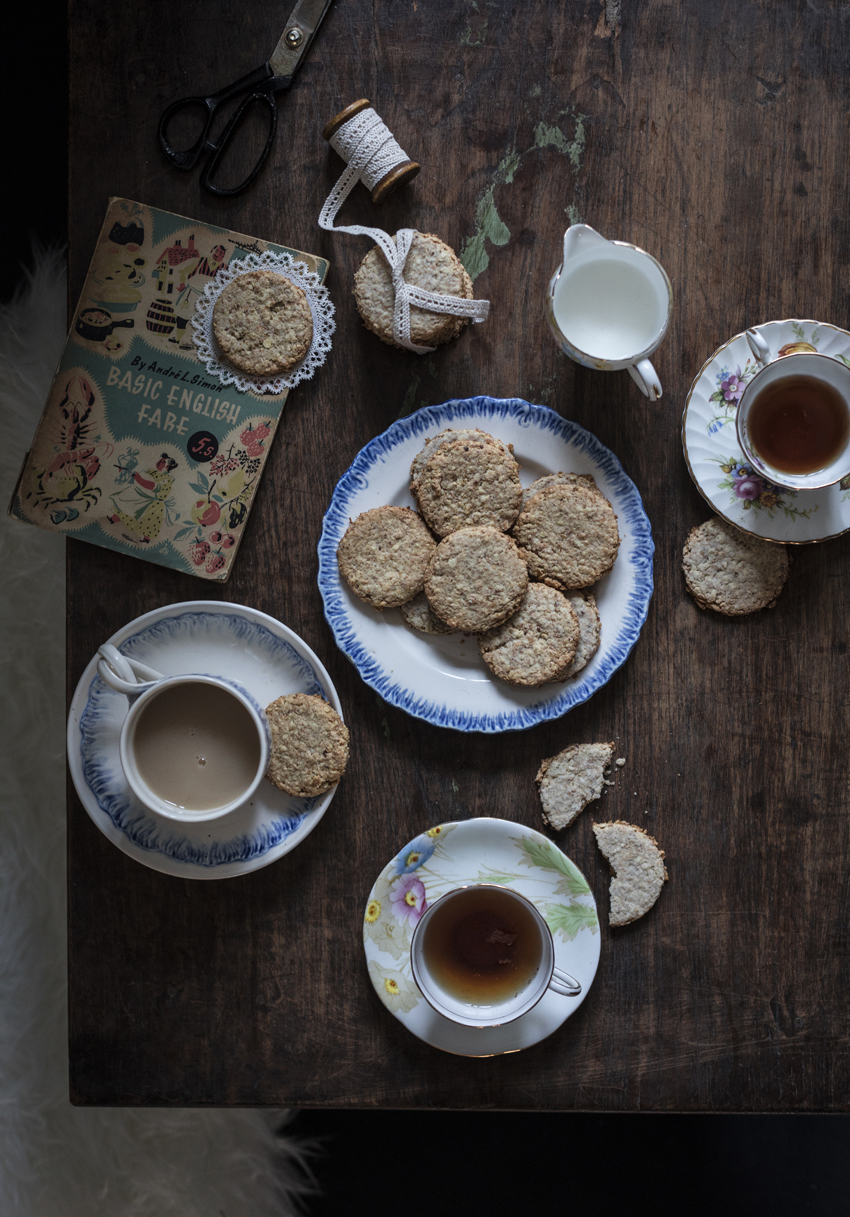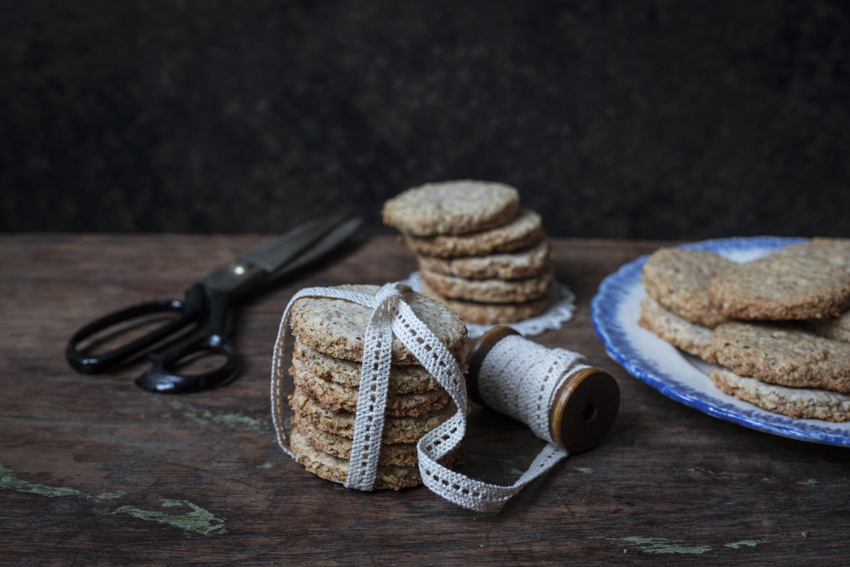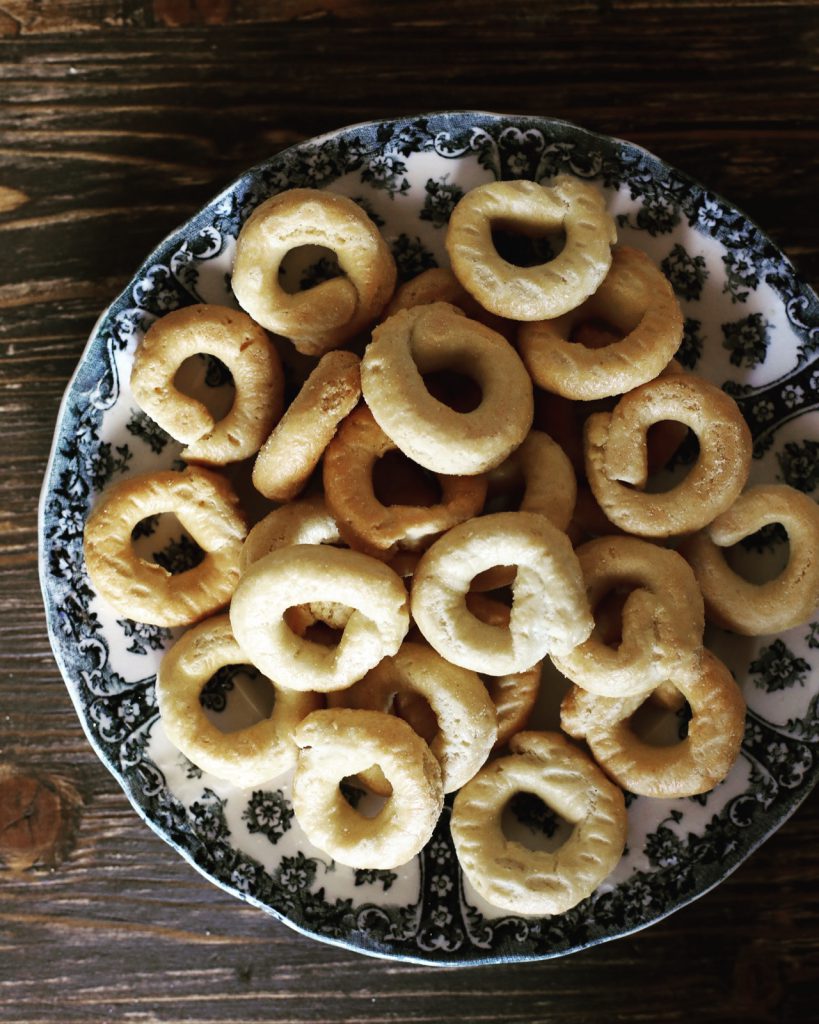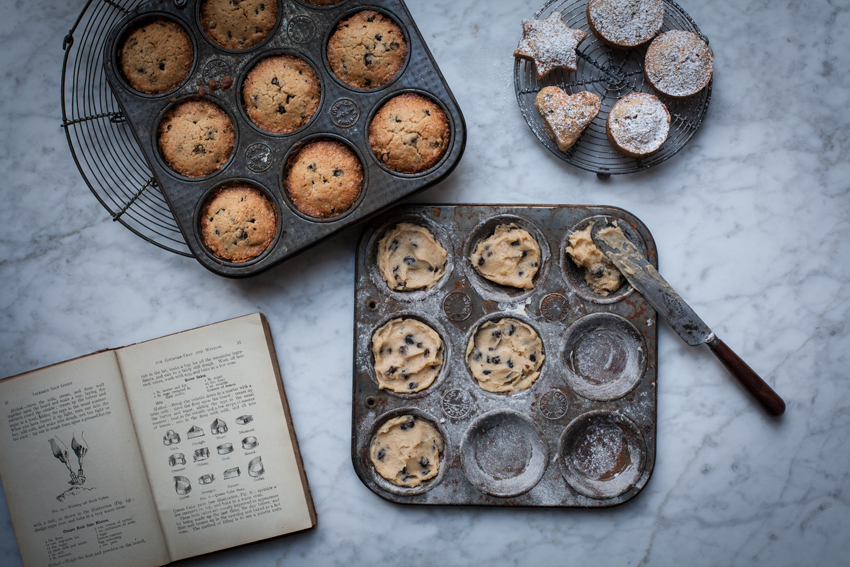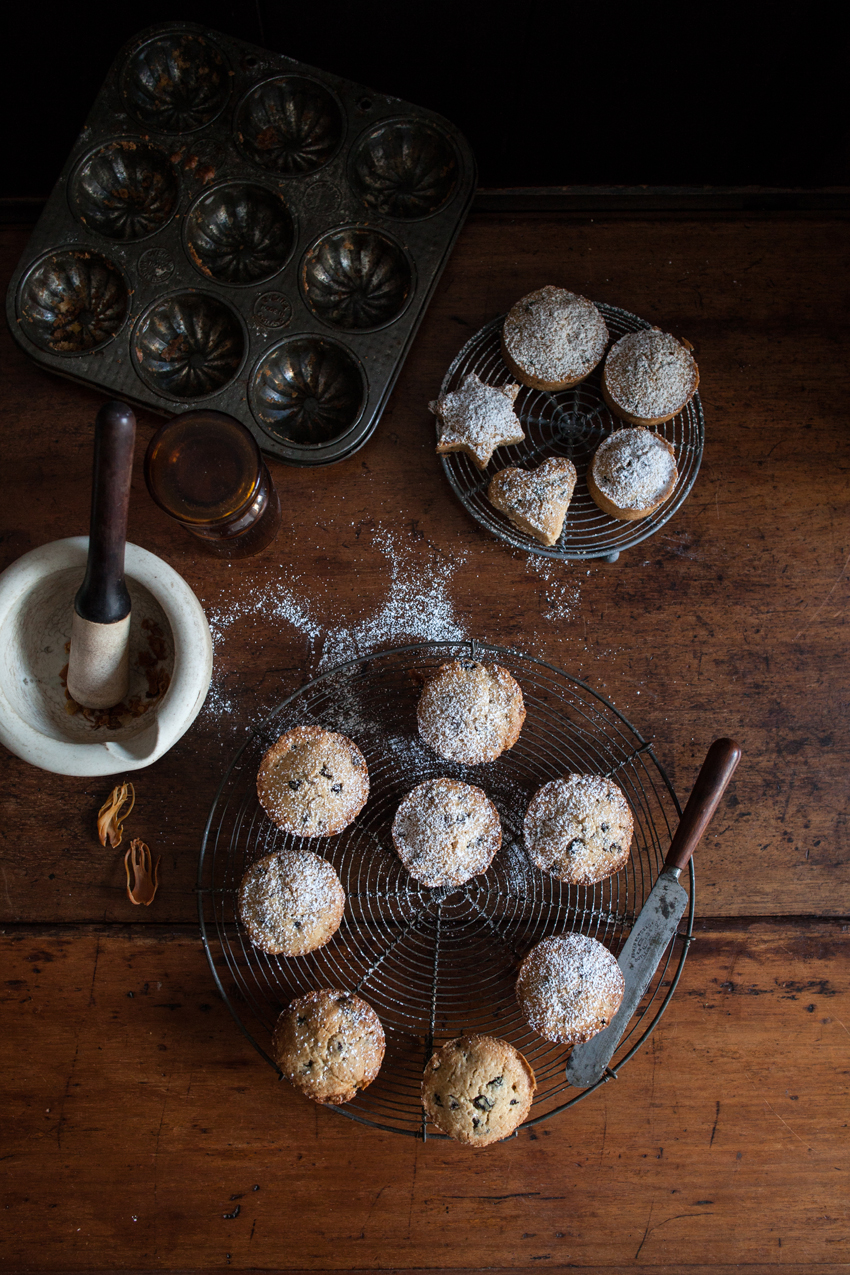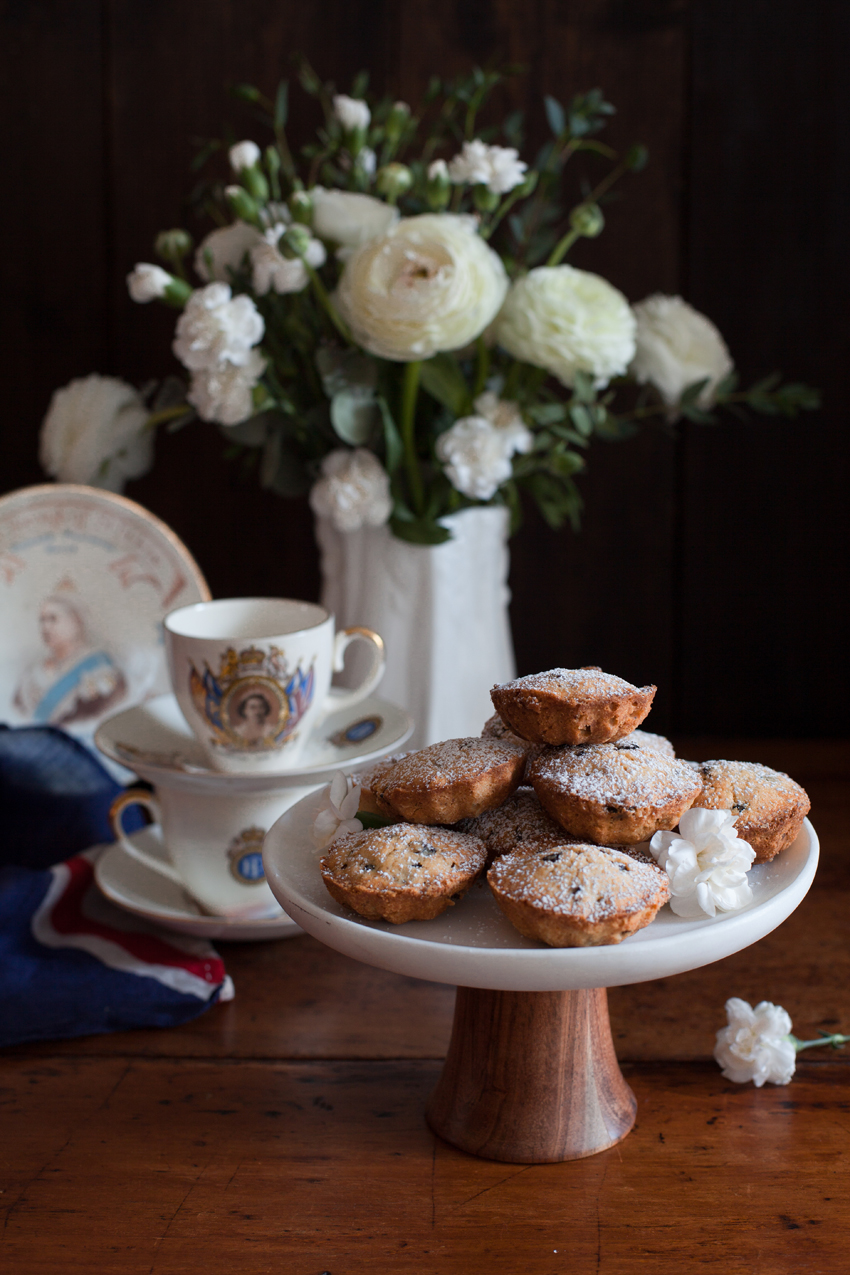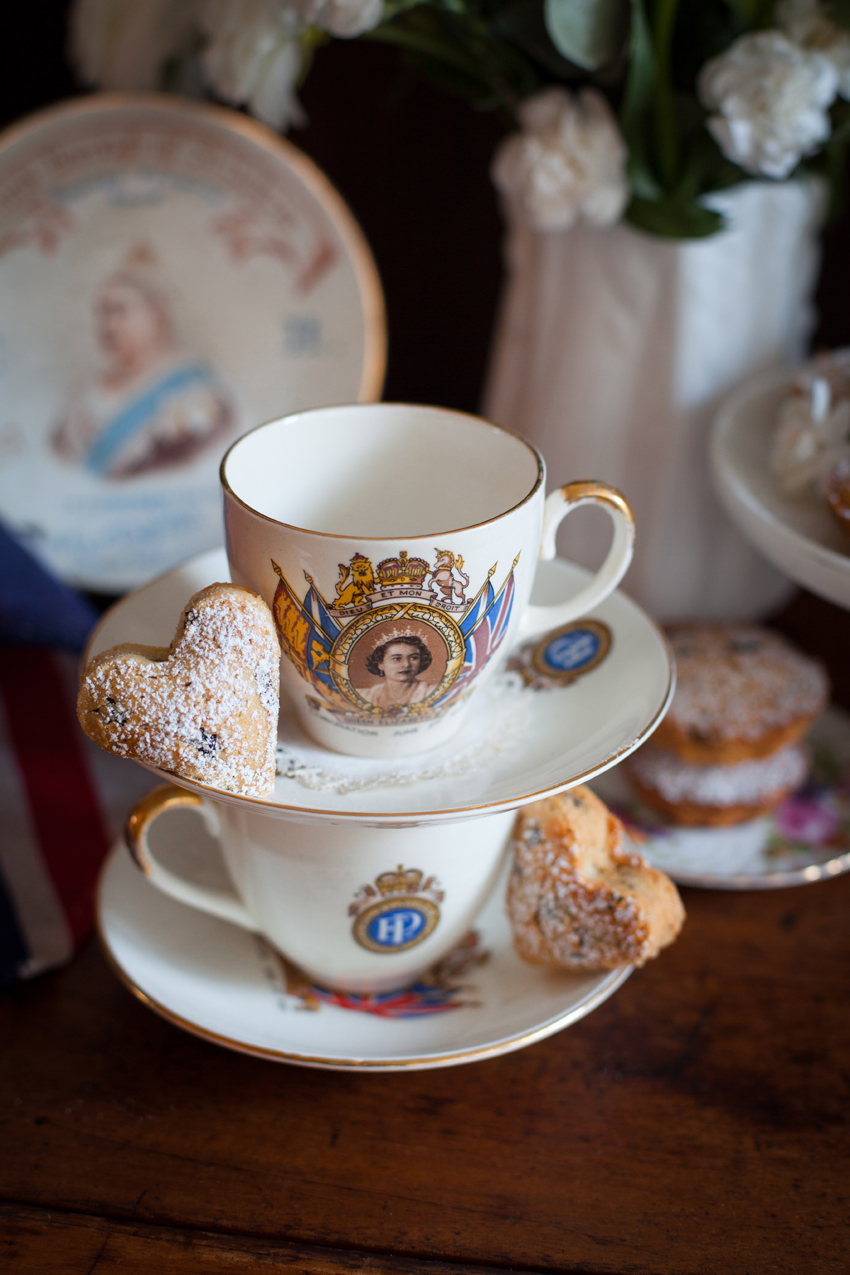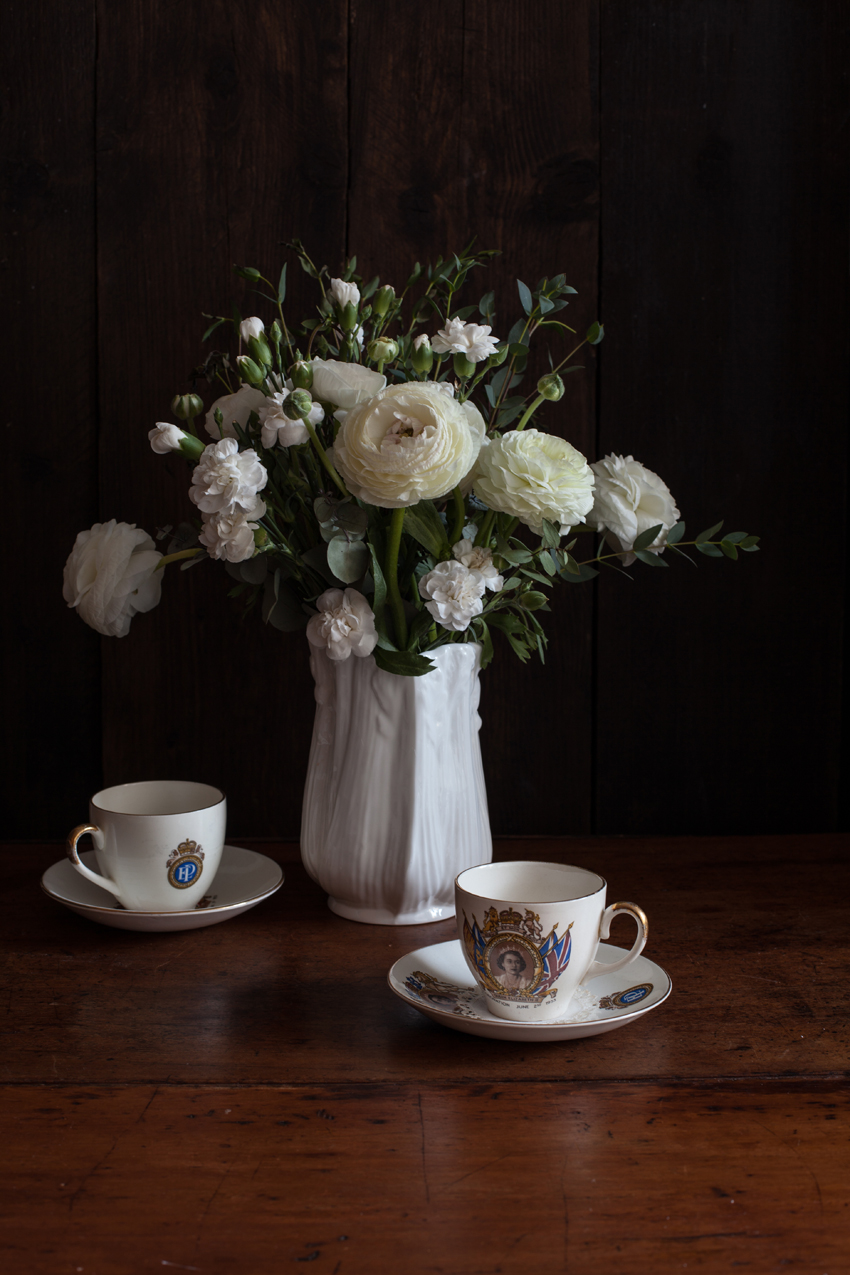The post Digestive Biscuits appeared first on Miss Foodwise.
]]>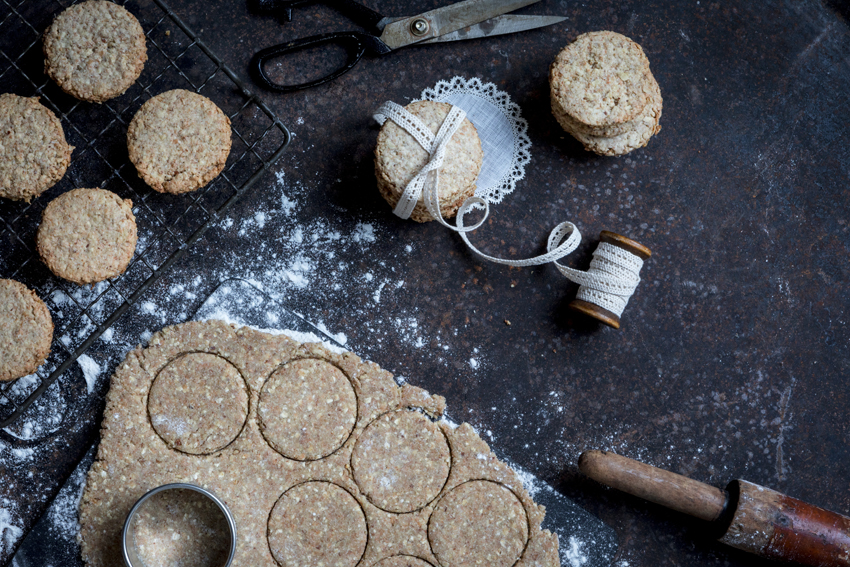 Update on my life: it’s been a little quiet on here because we’ve just bought a new house, sold our current one and are preparing for our move to the woods in April! Right now I’m planning my vegetable garden and new kitchen which is very exciting indeed. My aim is to go for durable and craftsmanship. The latter will probably mean I’ll be able to afford the kitchen cabinets this year (at least I hope so, or it will be vegetable crates!!) and the doors will maybe have to wait until next year. For my fittings I’m going for old established companies who have proven themselves with their quality. My impressive Esse stove will be the main feature, wood fired and surprisingly rated A+ with practically non-existent CO emissions due to new techniques. It’s an exciting time and I can’t want to show you how I get on, especially with vegetable growing! Also, I’m hosting a popup dinner in London 16/2 with Ms Marmite lover at her Underground Restaurant, it will be a (vegetarian) Flemish feast with Belgian beer! To book go here >
Update on my life: it’s been a little quiet on here because we’ve just bought a new house, sold our current one and are preparing for our move to the woods in April! Right now I’m planning my vegetable garden and new kitchen which is very exciting indeed. My aim is to go for durable and craftsmanship. The latter will probably mean I’ll be able to afford the kitchen cabinets this year (at least I hope so, or it will be vegetable crates!!) and the doors will maybe have to wait until next year. For my fittings I’m going for old established companies who have proven themselves with their quality. My impressive Esse stove will be the main feature, wood fired and surprisingly rated A+ with practically non-existent CO emissions due to new techniques. It’s an exciting time and I can’t want to show you how I get on, especially with vegetable growing! Also, I’m hosting a popup dinner in London 16/2 with Ms Marmite lover at her Underground Restaurant, it will be a (vegetarian) Flemish feast with Belgian beer! To book go here >
But on to the news of the day and that is Digestives!
An icon in British biscuit fare, it is illegal to call a digestive ‘digestive’ in the US and it could be one of the reasons the Beatles* split… Impressive for a rather plain looking tea dunker, but yet the biscuit is so adored that the chocolate covered one was elected as the number one biscuit to dip in your cuppa. This leaves the Rich Tea (see my recipe here) on second place, followed by the Hobnob and the plain digestive in fourth place. Shortbread to my amazement came in on ninth place, but then again I do never dunk a shortbread finger into my hot drink even though it’s shape lends it to this action perfectly.
A digestive and a hobnob are quite similar, but the hobnob uses rolled oats and white self-raising flour, while the digestive calls for wholemeal flour and baking powder. Digestives were developed in the 1830’s by two Scottish doctors in the aim to create a biscuit that could aid digestion, hence the name ‘Digestive’. The most popular Digestives are those produced by McVitie’s who started baking them in 1892. However, a recent glance at the packaging revealed their use of palm oil instead of good old butter, something that really infuriates me. It is probably cheaper and more stable to use palm oil, but really when I treat myself to a stack of biccies I want butter and no compromise.
Digestives were often called malt biscuits and the original patent granted for them was titled “Making Malted Bread”. Cassell’s Universal Cookery Book from 1894 gives a recipe for ‘Malt Biscuits’ following: “the recipe for Digestive Biscuits with malt as below may be followed…” He suggests that using ground carraway seeds are a suitable flavouring for persons who suffer from flatulence, but he also mentions that any other spice is optional too.
Recipes for Digestives feature humble ingredients and it should remain so, as my lovely friend Felicity Cloake puts it so well in her piece for the Guardian:
A digestive is not a biscuit that should draw attention to itself.
But on my quest to create my favourite Digestive I did sneak in a little more fancy ingredient and that’s ground up roasted pecans. In the recipe below I’ll give you the option to leave them out, but I find it gives something extra to the biscuit without making it too fancy, it makes it more filling requiring only one, maybe two, instead of a half packet if you skipped lunch. But feel free to leave it out. I also add oats, which is common these days with home made Disgestives. If you want to mimmic the store bought biscuits just use the wholemeal flour.
Enjoy these biscuits, the dough is easily made in advance if you want to serve them freshly baked to guests. They keep for 4 days in an airtight container or a ziplock bag.
*Now about the Beatles… I’m not making this up, the digestive incident was noted down by recording engineer Geoff Emerick in his book Here, There, and Everywhere: My Life Recording the Music of The Beatles. According to Emerick, Yoko Ono (John Lennon’s wife in case you’re from Mars) “was in the recording studio and at one point helped herself to Harrison’s box of McVitie’s while the Beatles were in the control room listening to a playback of the song they’d just recorded. Harrison got angry at Ono, and his subsequent outburst caused Lennon to lose his temper in response.” source
Further reading:
Recipe on this website: Rich Tea Biscuits
How to cook the perfect Digestive biscuit / Felicity Cloake for the Guardian
Chocolate Digestive is nation’s favourite dunking biscuit / The Telegraph
You’ll soon get seven fewer digestives in a packet / Metro
Digestives
Recipe
Makes about 40 biscuits, recipe can be halved.
- 40 g pecans (you can omit these and use 40 g extra flour instead)
- 150g unsalted butter at room temperature
- 100g demerara sugar
- 2 medium eggs
- 1 tsp seasalt
- 1 tsp baking powder
- 150 g rolled oats (small variety, not the large ones) or rough porridge oats
- 260g wholemeal wheat or spelt flour
Method
Roast pecans if you are using them, on a baking tray in the oven for 10 minutes on 200°C. Line two trays with baking parchment. Keep a +- 6 cm cookie cutter ready.
When the pecans (if using them) are cooled, blitz in a mixer until they resemble coarse flour but stop before you see it go oily.
Mix butter and sugar together (in a mixer if you have one) until creamy and add the eggs one by one. Then add the baking powder and start adding the pecans, salt, oats and flour teaspoon by teaspoon. It will take a while for the mixture to come together. The mixture will appear very dry at first but do not be tempted to add milk or water.
Use immediately or wrap in clingfilm and keep in the fridge for a short while or a couple of hours if you must.
When ready to bake, preheat your oven to 200°C if you haven’t already for the pecans. Knead for a few seconds and pat the dough down (the less rolling the better), place on a gently floured working surface or baking parchment and dust with flour too to prevent the rolling pin from sticking. Roll out to half a centimeter and cut out the cookies, transferring them to the lined baking tray. It’s okay to knead leftover dough back together and roll it back out to cut out more cookies, keep doing so until you have used up your dough.
Bake in the middle of your oven for 10-13 minutes, 13 minutes means darker biscuits which I prefer, they keep better too.
Pour yourself a hot drink and dunk your biscuit in it!
The post Digestive Biscuits appeared first on Miss Foodwise.
]]>The post Jumbles on the battlefield appeared first on Miss Foodwise.
]]>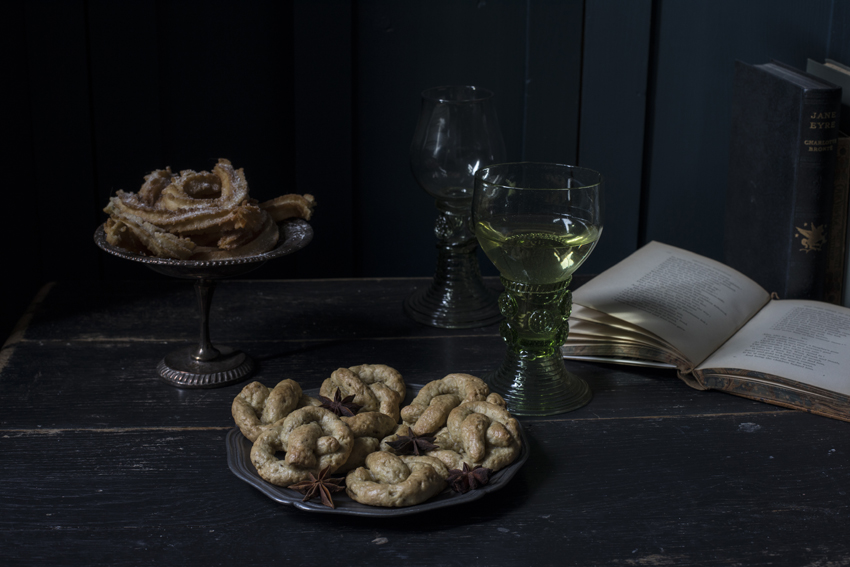 It has been a busy few months, flying from photography assignments and meetings in London to Latvia for research, London again, then to New York, two days after to Milan, then London again, then Milan again a few days ago. I have been spreading myself too thin, so over the Easter weekend, my first weekend home since somewhere in februari, I barricaded myself onto the sofa between stacks of pillows and two sleepy cats.
It has been a busy few months, flying from photography assignments and meetings in London to Latvia for research, London again, then to New York, two days after to Milan, then London again, then Milan again a few days ago. I have been spreading myself too thin, so over the Easter weekend, my first weekend home since somewhere in februari, I barricaded myself onto the sofa between stacks of pillows and two sleepy cats.
We are talking Jumbles today and I don’t mean gibberish.
I was following ‘A History of Royal Food and Feasting’, a fun free online course from the University of reading and Historic Royal Palaces with a lot of interesting historical information about food. A lot of the information I already knew but I did manage to learn a few things, plus it was just great fun to do and force myself to take some rest while still being productive. One of the dishes that were recommended to try on the course were Jumbles, a biscuit I had been meaning to bake but haven’t had the time in my mad schedule. When the Learning and Engagement department got in touch to check if I wanted to get involved to spread the word about the course I of course said yes because I enjoyed it. So Jumbles it was!
Jumbles were knot shaped biscuits that first appeared in the wonderful book The good Huswifes Jewell by Thomas Dawson, dating to 1585. But legend places this biscuit right at the heart of The War of the Roses a century before Dawson’s recipe.
For those who are unfamiliar with English history The Wars of the Roses were a series of battles fought in the period of 1455 to 1485 between two rival branches of the royal House of Plantagenet, the House of York and the house of Lancaster – both sporting a rose in their heraldic emblem. Both made a claim for the throne of England. They were a result from the social and financial problems following the Hundred Years’ War. The Lancastrian claimant, Henry Tudor defeated the last king of the House of York, Richard III at Bosworth Field, near Market Bosworth, a market town in Leicestershire. He then married Edward IV’s daughter, Elizabeth of York, to unite the two houses.
And it is precisely on this last battlefield that a new legend was born, at least a few centuries later…
The story goes that Richard III’s chef brought biscuits to the battlefield. These were even thought to be his speciality and the favourite of the king. After the battle when survivers were stealing valuables from the dead as was the custom, a recipe for these biscuits was found – because you should never go to war without at least one good biscuit recipe! The biscuits were promptly named Bosworth Jumbles. Or so the legend says since around the 1980’s.
To make Iombils a hundred.
Take twenty Egges and put them into a pot both the yolkes & the white, beat them wel, then take a pound of beaten suger and put to them, and stirre them wel together, then put to it a quarter of a peck of flower, and make a hard paste thereof, and then with Anniseede moulde it well, and make it in little rowles beeing long, and tye them in knots, and wet the ends in Rosewater, then put them into a pan of seething water, but euen in one waum, then take them out with a Skimmer and lay them in a cloth to drie, this being doon lay them in a tart panne, the bottome beeing oyled, then put them into a temperat Ouen for one howre, turning them often in the Ouen.
The good Huswifes Jewell by Thomas Dawson (London, 1585).
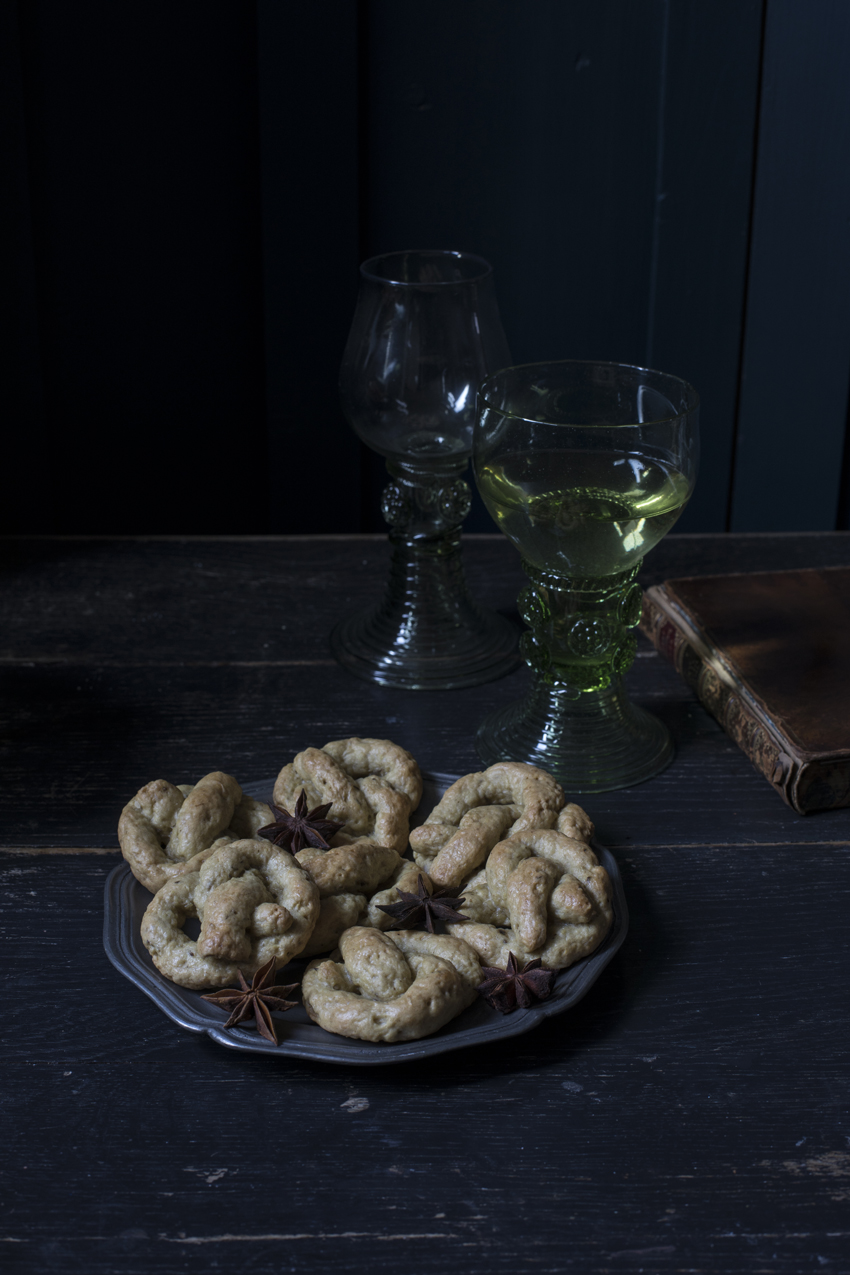 Although the word ‘jumble’ means ‘to make a hodgepodge out of things’ leading you to think it is called that way because of mixing a bunch ingredients, it is thought to come form the Latin ‘gemellus’ meaning ‘twins’ which might refer to the shape of the knot. It is a possibility since there is also a biscuit in Italy called ‘gemelli’ as in the Italian word for twins. In France there is the ‘gimblette’ a donut shaped biscuit which was hung from a rosemary branch on Palm Sunday in order to be blessed. Popular flavourings are candied peel and orange blossom water, sometimes also aniseed. The biscuits are first boiled, then baked, like the early English recipe also instructs. The Larousse gives as explanation for this bake: Petit gâteau en couronne, parfumé aux amandes. Spécialité d’Albi. No mention of the other flavourings. But I am not alarmed as The Larousse is often incomplete or wrong!
Although the word ‘jumble’ means ‘to make a hodgepodge out of things’ leading you to think it is called that way because of mixing a bunch ingredients, it is thought to come form the Latin ‘gemellus’ meaning ‘twins’ which might refer to the shape of the knot. It is a possibility since there is also a biscuit in Italy called ‘gemelli’ as in the Italian word for twins. In France there is the ‘gimblette’ a donut shaped biscuit which was hung from a rosemary branch on Palm Sunday in order to be blessed. Popular flavourings are candied peel and orange blossom water, sometimes also aniseed. The biscuits are first boiled, then baked, like the early English recipe also instructs. The Larousse gives as explanation for this bake: Petit gâteau en couronne, parfumé aux amandes. Spécialité d’Albi. No mention of the other flavourings. But I am not alarmed as The Larousse is often incomplete or wrong!
Another biscuit I find closely linked to the English Jumble, Italian gemelli and the French ‘gimblette’ is another Italian biscuit, this one from the island of Burano: the Buranelli or Bussolai Buranei. Often also called Essi when it is shaped in an S-shape instead of donut. Though theories on this site claim it was made for fishermen, I find it a little unbelievable since working class people would not have been able to afford the sugar. Traditional stories place the Buranelli or Bussolai Buranei around Eastertime, just like the French Gimblette. The island website of Burano tells the romantic tale that it was a tradition of Burano, a few days before Easter for the women to rent the ovens of the island’s bakeries to bake their bussolai for Easter. It is quite possible that this did indeed happen as it was a general custom all over Europe for people to go to their town or village bakery to have their bread, meat or beans cooked or baked. In Puglia and in Napoli they have a biscuit which is probably the most similar to the English Jumble: the Taralli. This biscuit, although always savoury is also first boiled then baked.
In the 16th century there was also the gimmell ring, again referring to the Latin word for twin ‘gemellus’ as mentioned earlier. The ring was made from two intersecting bands and if you hold them away from one and other they do kind of look like a pretzel or our old jumbles. My favourite 17th century poet Robert Herrick mentions the ring in one of his poems and he even calls it ‘a ring of jimmals’. I’ve always been intrigued by his words.
THOU sent’st to me a true love-knot, but I
Returned a ring of jimmals to imply
Thy love had one knot, mine a triple tie.
Works of Robert Herrick. vol I. Alfred Pollard, ed. London, Lawrence & Bullen, 1891. 217.
I find another possible early link in Bartolomeo Sacchi – Platina – De honesta voluptate et valetudine, dated around 1465. There the author shares a recipe for a ‘pastry which they call canisiones’ which he says to form into rolls, and bake in a gentle oven just like the recipe for marzipan confections on the page before. Jumbles in England were also sometimes made not from flour, eggs and butter, but from a sugar and fruit paste, or almond meal, very much resembling the marzipan biscuits of Platina.
‘Apricock Jumballs’ from an 18th century recipe from ‘English Housewifery Exemplified’ written by Elizabeth Moxon is such a flourless jumble, consisting only from sugar and apricots cooked until they become a stiff paste like fruit cheese. These were then cut in strips and made into complex knot creations which you can see in some Dutch still life paintings.
In the 17th century they also appeared in books and recipes can be found in Hugh Plat’s The Arte of Preserving Conserving… of 1609 and in The English Huswife by Gervase Markham in 1615. By then the dough was no longer boiled before being baked. Flavourings still include the traditional and still popular aniseed and caraway seeds. Sometimes sugar was added, sometimes it was left out. Rosewater is still being used, even as an icing mixed with sugar and egg white. While Plat instructs to create knots and uses almond meal and grated biscuits, Markham says you can make them in whatever shape you want and uses wheat flour.
Jumbles were mostly popular in the 18th century where they were served with wine, just like Italian biscotti to dip in Vinsanto.
Later recipes use yeast, presumably to create a lighter bake, then yeast is replaced by baking powder. In the 20th century all shapes are a go and jumbles are even made into letters as instructed in the Reform Cookery Book‘ by Mrs. Mill in 1909. Recipes for jumbles today, like used on the Bake Off last year, are more crumbly and short textured.
The recipe
I chose to give you the recipe which calls for poaching the biscuits like the earliest recipes stated because I tested the biscuits only baking them and the poached ones came out much nicer and covered in a pearly exterior as if they had been egg washed. The baked ones were just looking like a dry biscuit. They are dry though, don’t think like you’re going to experience a nice short texture, it is definitely more chewy and I assume these biscuits were made to keep relatively long. It is even possible they would have used them for decoration too. In any case I am keeping some to see how long they keep and as soon as I break my tooth on one.
What do you need
- 70 g raw cane sugar
- 1 tsp caraway or aniseed
- 2 eggs
- 1 tbsp full-fat milk
- A pinch of salt
- 200 g all-purpose flour
- 1 tsp rosewater
Method
Use a mortar and pestle to crush the caraway or aniseeds, if your mortar is large enough, add the sugar and bash them together to get the flavour into the sugar.
Transfer seeds and sugar to a large bowl and mix in the eggs and milk.
Add the pinch of salt and the flour and work the mass into a stiff dough.
The dough is quite dry, yet still a little sticky, but that is what you need to roll it out succesfully.
Leave the dough to rest for an hour or so if you have the time, if not, proceed by rolling out the dough in 26 cm snakes for the knots.
Preheat your oven to 180°c and place a baking tray in it to get hot. Keep another baking tray aside and line it with kitchen paper or a tea towel.
Keep a fine pastry brush and 1 tsp of rosewater ready in a small bowl, I tend to use an eggcup for this. Make the knots like for pretzels or any other knot shape you desire. Use the rosewater to moisten the ends of the snakes to attach them to the knot, it might seem like they do not stick together but leave them for a few minutes while you do your other knots and you will see they are stuck together.
Bring a generous amount of water to a simmer in a large pot.
Have a spatula ready to immerse the knots into the water and poach them for 10 minutes.
Transfer the knots onto the baking tray you lined with the kitchen paper or tea towel and dry them gently.
Now line the hot baking tray with baking parchment and arrange the knots onto it. Bake them in the middle of the oven for 25-30 minutes or until the biscuits start to blush a little orange, they should not be baked golden brown.
Transfer to a wire rack and leave to cool.
Further reading
Ivan Day’s post here >
In which he mentions something interesting about these knot biscuits:
In The New World of English Words (London: 1678) Edward Phillips defines the name for this confection thus, ‘Jumbals, a sort of Sugared past, wreathed into knots’. These knotted delicacies were usually made with a kind of biscuit or marchpane dough and were baked. They probably emerged from the craze in the 1570s for knotted strap work.
The inventory of the culinary heritage of France: Midi-Pyrénées, Éditions Albin Michel, 1996
The post Jumbles on the battlefield appeared first on Miss Foodwise.
]]>The post Queen cakes – 18th century dainty bakes appeared first on Miss Foodwise.
]]>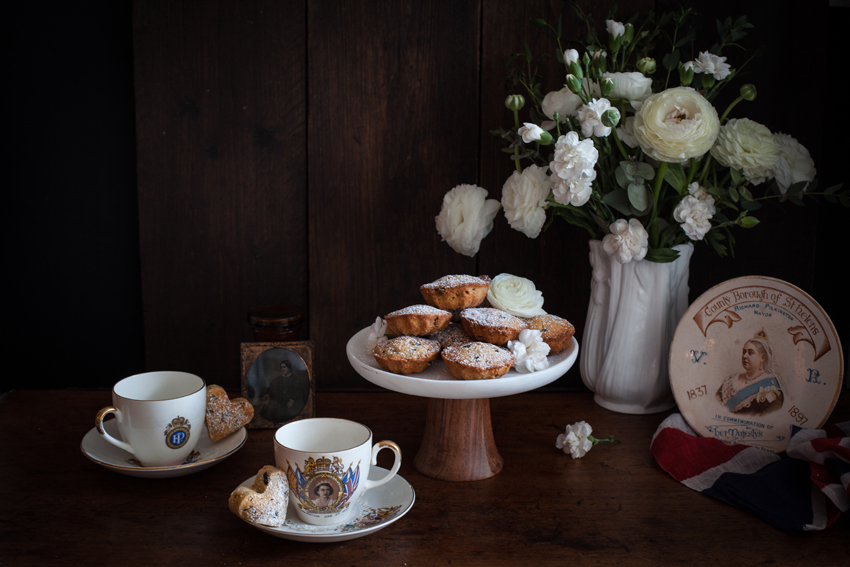
It is not a coincidence that I chose to write about Queen cakes today. If you’ve read the papers and watched the news, or if you are a royalist, then you know today the Queen of England celebrates her 90th birthday. This makes her the world’s oldest-reigning monarch and the longest reigning monarch in English history. Queen Victoria was the previous record holder with her 63 years and seven months. So Queenie has every reason to be smug and have a big party – which is a giant street picnic on the Mall (the strap of wide street in front of Buckingham palace) in june. Getting a ticket for it was near impossible to my regret, because this was a celebration I would have been happy to buy a new hat for, bunting I already have aplenty. So if you’re reading this Your Majesty… is there room for one more? I’ll throw in a book!
But let’s talk about these Queen cakes. They are little cakes, and they started popping up in English cookery books in the 18th century. When reading the several recipes from the 18th to the 20th century I have in original cookery books, they remind me of a little cake I grew up with in Belgium. However, the recipe was slightly different as the Belgian cakes were flavoured with a little vanilla or almond essence, while Queen cakes are flavoured with mace, orange flower water, rose water and lemon depending on the date of the recipe. The Belgian cakes also look more like Madeleines, but they both have currants in them and the use of vanilla or almond essence is of course a slightly more ‘modern’ way to flavour bakes.
As with many English dishes, the Queen cakes come with their own dedicated cake pans. These were produced in the 19th century and depictions of them can be found in at least two books that I know of, one I own. 18th century recipes remain silent about the tins they should be baked in, but it is very possible that the then fashionable mince pie tins would have been used, leaving them without a need to create new tins.
Buying dedicated cake tins was of course an investment, and if you weren’t going to bake Queen cakes every week, rather extravagant. Cookery book author Mrs Eliza Rundell (1806) suggests to use either little tins, patty pans, tea-cups or saucers to bake the batter in. She gives two similar recipes, one with rosewater and currants, another with grated lemon rind omitting the currants. She uses a pound each of butter, flour, sugar and currants to 4 modern eggs.
The earliest recipe appears to be that of Robert Smith (no not that fellar of The Cure) in 1724 in his ‘Court Cookery: or the Compleat English Cook’. He instructs to make his Queen’s Cakes with currants, washed, picked and rubbed clean, and flavourings which are a little Mace and orange flower water. He also uses a pound each of butter, flour, sugar and currants but about 5 modern eggs, omitting half the whites.
Take a Pound of dry’d Flower, a Pound of refin’d Sugar sifted, and a Pound of Currans wash’d, pick’d, and rubb’d clean, and a Pound of Butter wash’d very well, and rub it into the Flower and Sugar, with a little beaten Mace, and a little Orange-Flower Water; beat ten Eggs, but half the Whites, work it all well together with your Hands, and put in the Currans; sift over it double-refin’d Sugar, and put them immediately into a gentle Oven to bake.”
Court Cookery: or the Compleat English Cook, Robert Smith, 1724
Jumping to 1907 Frederick Vine gives an illustration (see book in picture above) of the Queen cake pans in his book ‘Saleable Shop Goods’. There are heart, clover, triangle, square, round and cutlet shapes. The recipe in this book uses a lot more flour (so less sugar) and only lemon essence, no currants in the batter, but he does instruct to sprinkle them on top of the cakes just before baking.
In the early 20th century recipes for Queen cakes aplenty with books often giving the option of 4 different recipes. Currants are back into the batter and several flavourings and toppings are suggested. It is quite possible that queen cakes were a term for all kinds of small cakes, much like fairy cakes or cupcakes. The recipe I’m giving you today are 18th century Queen cakes, recipe adapted (meaning recreated, I didn’t mess with it) from Robert Smith …
Some notes to the recipe
I find the cakes too sweet because they use an equal amount of sugar to butter and flour so I would definitely reduce this to 150 g. You can reduce the amount of currants to half, you will still have plenty of currants. Robert Smith suggests using your hands to mix everything, which I have done and worked much faster and better with the currants. Frederik Vine in his 19th century book tells us to use a palette knife to transfer the batter to the cake tins and I find that indeed using a small palette knife or blunt butter knife to do this works best. The original cake tins used for these looked a lot like cookie cutters with a base, but because the batter is so solid you can use cookie cutters placed on baking parchment (well buttered and dusted with flour of course) and fill these. In the past, cake tins or hoops didn’t always have a base. Finally, you could use self-raising flour if you want a lighter bake… this was done in the 19th century too.
What do you need – makes 20-22 cakes
- 250 g soft butter
- 250 g raw cane sugar
- 1/2 tsp ground mace (use mace blades bashed in a mortar, ready ground will give another result)
- 2 tsp orange flower water
- 250 g currants, soaked if you have the time
- 250 g flour
- 4 eggs, separated, of which one white discarded (nothing will go wrong if you leave it in)
Method
Prepare small cake tins, or cookie cutters about 5cm wide by generously buttering them and dusting them with flour.
Preheat your oven to 160°C
Cream butter and sugar as you would for regular pound cake. Now bash your mace blades in a mortar, I used two but any leftover can be kept in a jar for future use. Pour in the orange flower water and add the egg yolks one at a time.
Sift in the flour and mix well, the batter is quite dry for a cake batter so don’t be alarmed by this. When thoroughly combined, fold in the currants. I use my hands to combine the flour with the rest of the batter, you will soon see that this is indeed the best option and our 18th century writer is right (see note to the recipe above).
Whisk your egg whites until stiff, then fold into the batter with a spatula.
Use a palette knife to transfer batter to your cake tins, spreading it evenly.
Place in the middle of your preheated oven and bake for 30 minutes or untill golden brown. The cakes should have a dome from rising in the oven. When flat, they are tough.
Remove from the tins after 2 minutes and cool on a wire rack.
Finally, when cooled, dust with icing sugar and serve.
You Might also Enjoy
Francatelli’s Queen Victoria and Albert pudding >
The post Queen cakes – 18th century dainty bakes appeared first on Miss Foodwise.
]]>